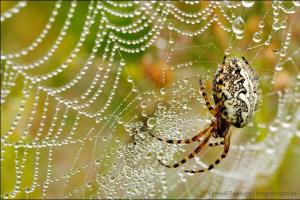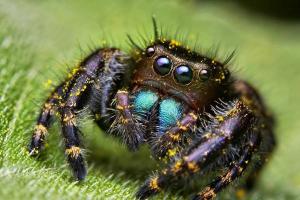Sooner or later, they encounter problems associated with the deterioration of the health and decorative value of potted flowers. If there are spots on leaves of one or another species from your flower collection, it is necessary to determine the cause of damage to the leaf blades as soon as possible.
It is possible that the appearance of spots on the leaves is caused by sunburn and it is necessary to shade the flower from direct sun rays. Typically, such damage appears in the summer - yellowish or brown round spots are clearly visible on the leaves, the leaf blade is deformed, and turgor decreases.
But spots on the leaves may appear due to damage to the indoor plant pests(spider mites, flower thrips, scale insects, whitefly larvae, mealybugs, white or green aphids), fungal diseases(mycoses are caused by powdery mildew, gray mold, late blight, fusarium, anthracnose), bacterial diseases(bacteriosis), as well as viral infections, causing leaf spot.
Usually, novice gardeners are faced with damage to plants by pests or diseases, who commit violations in the process of caring for “green pets” at home. Therefore, it is important to carefully inspect all potted flowers as often as possible in order to quickly take action if spots are detected on the leaves. It is much easier to fight pests and diseases at the initial stage of their appearance than after significant areas have been affected, when the chances of saving the plant become less and less.
♦ WHY DO BLACK SPOTS APPEAR ON THE LEAVES OF FLOWERS?
◉ fungal disease phyllosticosis (brown spot). On initial stage lesions appear dark purple and black dots. Gradually, the dots increase in size and turn into brown or black spots on the leaves;
◉ fungal disease septoria. At first, you can find small oval spots of light gray color with a brownish border on the leaves. Gradually, the affected areas of the leaves increase in size and black spots appear in the central part, consisting of spores of the Septoria fungus. Then the mycelium spreads throughout the drying leaf and the color of the leaf blade becomes brown;
◉ fungal disease powdery mildew. At the initial stage of the disease, small spots with a grayish coating appear. The mycelium quickly expands, small spots merge, darken, and black spots with spores may appear closer to the center of the leaf blade;
◉ sooty fungus. Blackheads often appear on the secretions (honeydew) of pests such as aphids, mealybug, scale insects, thrips. Sticky honeydew remains on the leaves, and then a black coating and small dark or black spots appear;
◉ another dangerous mycosis - black rot. Dark spots may appear first. Brown with yellowish concentric rings. Gradually, the spots increase in size, darken and the entire leaf literally turns black;
◉ bacteriosis bacterial rot. Most often appears on fleshy leaves indoor plants. At the initial stage of the disease, small spots of brown or black color can be detected. Gradually, the leaf tissue softens and areas of the leaf blade become necrosis.
Photo: black spots on the leaves of indoor plants
♦ WHY DO YELLOW SPOTS APPEAR ON FLOWER LEAVES?
❂ improper care behind the plant (watering cold water, overflow and stagnation of water in the root system, incorrect fertilizing with fertilizers, inappropriate soil mixture). At first, shapeless yellow spots may appear on the lower leaves, yellowish dots along the veins. Due to waterlogging or stagnation of water in the roots, blurry yellowish spots appear on thin leaf blades;
❂ drafts and prolonged ventilation of the room. So-called draft spots may appear on flower leaves due to overcooling of the root rosette. Yellow spots of irregular or blurred shape are scattered throughout the leaf blade;
❂ sunburn. Sunburn can occur after watering or spraying when the droplets on the leaves act like lenses. Round or oval yellow spots with a reddish-brown rim are noticeable on the leaves;
❂ fungal disease peronosporosis (downy mildew). Grayish-yellow spots with a blurred outline appear on the upper side of the leaf blade. The mycelium quickly increases in size and the spots merge;
❂ bacteriosis bacterial spotting. First, glassy spots with a blurry rim appear. Soon these spots on the leaves turn yellow, and then increase in size, turn black and the leaf dries;
❂ pests of indoor plants suck juices from tissues. At first, you may notice small yellowish dots on the leaves. Gradually, the pests multiply, there are more and more spots and they increase in size, turning into yellow spots.

- photo: yellow spots on the leaves of indoor plants
♦ WHY DO WHITE SPOTS APPEAR ON THE LEAVES OF FLOWERS?
◎ fungal disease powdery mildew. First, a grayish coating appears, which is easily removed mechanically. Then the entire leaf is covered with shapeless white spots, which over time become dark brown or brown;
◎ fungal disease gray rot. In the initial stage it usually appears on damaged and withered leaves in the form of shapeless brownish or brown spots. But after some time, white spots can be detected - this is a coating under which the color of the spots is rusty or brown;
◎ plant damage by thrips. The areas of the leaf blade affected by pests become covered with white spots. If you look closely, you can also find tiny black thrips excrement there.

- photo: white spots on the leaves of indoor plants
♦ SPOTS ON LEAVES IN DIFFERENT TYPES OF FLOWERS:
⊛ Anthurium. Irregularities in the watering regime lead to the appearance of yellow or rusty spots on the leaves. An improperly prepared soil mixture that decomposes and cakes can lead to the appearance of blurry yellow spots, and the leaves themselves are deformed. Anthracnose often affects Anthurium Andre (Male Happiness), which leads to the appearance of dark spots and drying out of the leaves. Frequent drafts and low temperatures lead to the appearance of black dots and small spots. Small translucent dark spots on the leaf blade they indicate possible damage to the anthurium by spider mites. And numerous yellowish spots against the background of deformed leaves may be the result of the activity of aphids sucking out the anthurium juices.
⊛ Orchid(phalaenopsis, dendrobium). If dry spots of a brownish or brown color appear on the leaves, then most likely this is an infection with the fungus Cladosporium Orchideorum. If you constantly water an orchid with cold water, you can provoke the appearance of uneven depressed yellow spots - this is the so-called death of leaf tissue cells (Mesophyll collapse). At high level Due to high air humidity, circles and yellow spots of Cercospora bacterial spot may appear on the leaves. The fungus Phyllostictina Pyriformis causes small yellow and black spots to appear on the top of the leaf - and especially along the edges. Appearance of black spots different sizes can cause chlorosis if you water the orchid with unsettled running water.
⊛ Ficus(Benjamina, rubbery elastica). The upper part of the leaf blade is covered with small yellowish and dark spots, a cobweb is visible between the shoots and leaves - this is a spider mite attack. Sticky secretions of pests (scale insects, thrips, mealybugs) can provoke the appearance of sooty fungus on the leaves. Gray rot causes darkening of the leaves and the appearance of spots with a grayish coating on the surface. Ficus plants are often affected by powdery mildew, when white spots with plaque appear on the leaves.
⊛ Saintpaulia(Usambara violets). Very susceptible to direct sunlight, with prolonged exposure to which burns appear on the leaves in the form of oval spots yellow color with a brownish central part. Cold air and constant drafts provoke the appearance of gray-beige spots of various shapes. Dark spots may appear along the edges of the lower leaves of violets if the plant has not been replanted for a long time or the flower lacks potassium. Powdery mildew causes white spots with a powdery coating to appear, and then the leaves turn brown, become deformed and fall off.
to Home PageALSO FIND OUT...
There are a variety of diseases of indoor flowers, some of them are complex, requiring a special approach to treatment and preventive measures in the future. Rust is a disease of indoor plants - rare, but dangerous, capable of destroying a flower. The name of this flower disease is explained appearance lesions: red and brown spots appear on the leaves of house plants, slightly convex and as if fleecy. In fact, it is a fungus. Treatment of domestic flowers affected by it is long and complex. It is imperative to reconsider the conditions in which the plant is located and the care regimen.
A ficus completely infected with rust is very difficult to cure.
It is not so difficult to recognize rust on plants; the signs of this disease are specific, they cannot be confused or missed.
- First, rust appears on the leaves and stems of domestic flowers. It looks like yellow-brown or red-brown convex spots of various sizes and shapes.
- The spots increase in size, swell and form pustules. The leaves of diseased plants intensively evaporate moisture, the pustules quickly dry out, crack and burst. They release a “rusty” powder, which poses a serious threat to neighboring healthy plants. These are fungal spores that quickly spread through the air throughout the flower garden.
- Then the spores completely cover the entire surface of the leaves and stems and appear on the flowers. Plants change color, becoming brown or brown.
- Then indoor flowers begin to dry out and lose leaves; if treatment is not started, the plants will die.
However, even if you start taking measures, it is not always possible to save indoor plants from disease. Therefore, it is better to prevent its appearance and development.
Important to know: at temperatures not exceeding 10 degrees above zero, incubation period The disease lasts up to 20 days. If the temperature is above 18 degrees, then the incubation period is reduced to 7-14 days.
Reasons for appearance
Rust is a fungal disease, and the fungus, as you know, likes to settle in places where it is humid, warm and dark. From this we can conclude that rust appears on plants if they are watered too often and abundantly, not ventilated and kept in the shade, away from direct sunlight or phytolamps.
It is especially dangerous to flood indoor plants with water in winter. Many flowers in the cold season go into a dormant state until spring; they do not need frequent watering, nor do they need mineral fertilizing. If, in addition to this, the pot is located near the radiator, you should not be surprised at the appearance of such a plant disease.

Over-watering indoor plants can lead to rust infection.
Also, the development of fungus can be provoked by the abuse of mineral fertilizers rich in nitrogen. In winter they are not needed at all. And during the growing season and flowering of plants, you should strictly follow the instructions and do not apply too high a concentration of fertilizer.
If pots with plants are standing on open terrace, veranda or balcony, then fungal spores can be carried by the wind or insects. Sometimes you come across seeds that are already infected with rust. Recognizing this is difficult, often completely impossible. This is one of the reasons why seeds should be treated with potassium permanganate before sowing. As well as the containers with soil in which they will be planted.
Which indoor plants suffer more often than others?
In principle, rust can appear on any type of indoor plant. But the fungus loves certain varieties more than others. In addition, there are house flowers that are more sensitive to fungal spores and are unable to fight it. The following ornamental crops should be protected from moisture and overheating with special care:
- camellia;
- fuchsia;
- carnation;
- cyclamen;
- pelargonium;
- rose;
- geranium;
- chrysanthemum.

A cameo leaf damaged by rust cannot be treated.
This fungus likes to settle on garden crops such as asparagus and citrus bushes, and often affects palm trees of various types.
We treat and prevent disease
In most cases, a flower garden suffers from rust due to the fault of the owners themselves - this means that they do not properly care for their plants. To prevent the formation and spread of fungus in the spring, all flowers should be treated with a one percent solution of Bordeaux mixture.
What to do if a fungus has settled on the plant and its leaves begin to rust? First of all, it is important to prevent infection of neighboring plants, even if the diseased flower cannot be saved. Therefore, a sick flower must be immediately taken to a hotel room. Every single one of the affected leaves is torn off, even if there are only a few small spots of rust on them. Then they need to be burned away from the flower garden.

Bordeaux mixture is used to combat rust on indoor and garden plants.
The flower itself can be treated with the same Bordeaux mixture. Or use sulfur dust. You can also prepare the following disinfectant mixture yourself:
- heat 5 liters of purified water;
- dissolve 200 g of green soap in water;
- add 15 g of copper sulfate.
The room in which the potted plant is located must be well ventilated several times a day, and it is better to generally keep the window open all the time. Neither dry air nor high humidity should be allowed.
It is important to water the plant correctly. The liquid should be added to the pan or to the soil, but so that the water gets under the root and not on the leaves and flowers of the plant. If fertilizing is used, then preference should be given to preparations containing potassium and phosphorus.

Copper sulfate is a component of a spray preparation that you can prepare yourself.
Beginning gardeners often confuse rust with any red spots on the leaves of plants and begin to spray the flower garden with various fungicides. As a result, many plants die from improperly applied products. Therefore, if you suspect that a plant has been damaged by a fungus, you should either familiarize yourself with high-quality photos symptoms and manifestations of the disease, or invite a knowledgeable person to examine the plants and diagnose them.
Rust can also manifest itself differently in different flowers and crops. On some flowers it develops faster, on others it grows very slowly, over weeks or months. In any case, the plant needs to be treated, the most important points in this process – ensuring constant influx fresh air and removal of affected parts of the flower. It is recommended to re-treat with a disinfectant solution 10-12 days after the first spraying.
We present diseases of indoor plants with photos and names: fungal, bacterial, physiological and viral. Look at the photos for the most popular diseases of home flowers by type in alphabetical order.
Fungal diseases of indoor plants with photos
Fungal diseases are the most common. Many indoor and outdoor animals suffer from them. garden plants(vegetables, ornamental crops, shrubs and trees). Fungi penetrate through the roots along with or through damaged areas of the stem and leaves with dust.
Indoor plants also act as carriers of fungal diseases:, or. Spores of a fungus, often sooty, settle in their sweet secretions (honeydew), and the flower begins to become infected.
Fungi are characterized by a high rate of reproduction and spread over the surface of the plant. Diseases mainly appear as spots or plaque on the leaves or stem.
Fungal diseases of indoor flowers
Alternaria blight, anthracnose, ascochyta blight, red burn, root rot(“black leg” + late blight) and powdery mildew (+ downy).
As well as leaf rust, sooty fungus (niello), septoria, gray rot, tracheomycosis (verticellosis + malsecco and fusarium) and phyllosticosis (brown spot).
Anthracnose
Anthracnose
Root rot and late blight
Diseases of this group are most often caused by fungi of the genera: Phytophthora, Pythium and Rhizoctonia. The plant becomes infected from the roots, progressing symptoms of the disease become visible on the above-ground parts.
Therefore, the leaves on young specimens (seedlings) have not yet turned yellow, and the roots with the lower part of the stem have already rotted.
Leaf rust

Leaf rust
Sooty fungus

Sooty fungus (niello)
Gray rot

One of the most pressing problems for people who grow flowers at home is diseases of indoor plants. The cause of their occurrence may be unfavorable conditions. For example, a plant will be uncomfortable if there is a lack of nutrition or an excess of it, or at too low or very high temperatures.
An indoor flower may well get sick if the soil substrate does not have enough good quality. It is worth noting that if diseases of indoor plants are caused by precisely such external factors, then they do not pose a threat to other house flowers.
If you understand and eliminate the cause that caused the disease in your houseplant in time, you can avoid further problems. So, pests and diseases of indoor plants are our enemies. This means you need to learn to fight them.
Diagnosing the causes of diseases in indoor flowers
Protecting plants from diseases is a troublesome task. If the leaves of a domestic inhabitant begin to change color, you should immediately carefully examine its root system. If the roots of the plant are alive, the cause of yellowed leaves is most likely a lack of light and essential nutrients. To eliminate the problem, you should partially replace the soil and be sure to add suitable fertilizers.
If the flower is a light-loving flower, then move it to the brightest window in your apartment. Often young seedlings die if they do not have enough light. However, there are also plants that, on the contrary, suffer from too much large quantity bright sunlight. These include ferns, aspidistra or begonia. In the sun, their leaves begin to quickly turn yellow.
Shade-loving plants must be placed on windows in the northern part or in the back of the room. If you notice that the tips of the root system have lost their freshness, then you should conclude: the leaves have turned yellow due to dry soil or, perhaps, from excessive waterlogging.
In this case, carefully check the drainage to see if it is clogged. Remove all excess soil: about two centimeters from the surface of the roots should remain. Transplant the flower itself into a smaller pot.
What do excessive humidification and dry air lead to?
Pay attention to one very important thing: Too much moisture can lead to acidification of the soil. And this, in turn, can cause disease in indoor plants and rotting of the young root system. This may not only cause the foliage to begin to turn yellow, but the flower itself will begin to die.
In some cases, the leaves turn yellow due to a sharp change in temperature: from high to fairly low. For example, in winter the windows were left open for a long time in a heated room.
Dry air is perhaps one of the most important reasons that most often leads to diseases of indoor flowers. In such a microclimate, various pests will appear faster - spider mite or thrips. This means that in order to protect plants from diseases, it will be necessary to increase the humidity.
You can humidify the air by spraying from a spray bottle. I would also like to note that watering with cold water is extremely harmful for indoor plants. This is a common cause of root system diseases. Houseplants need to be watered with water. room temperature. And if the water is a couple of degrees higher, then this is an ideal option.
Prevention and treatment of flowers
Powdery mildew is a disease caused by a fungus called Sphaerotheca pannosa. Favorable conditions for its development - high indoor humidity (from 60 percent) and warm air.
When the disease is in early stage, small powdery spots appear on plant leaves and flowers. They are easily erased, but then reappear, become denser over time, and acquire a rich gray tint or even brown.
Powdery plaque sometimes appears on both sides of a plant leaf. Gradually they begin to dry out and fall off, and the growth of the indoor plant stops.
Regarding prevention powdery mildew, it is recommended to carry out pollination. Sulfur is optimal for this. Pollination should be done three to four times a year.
Overfeeding house plant nitrogen-based fertilizers, especially during the period of bud emergence, increases the risk of this disease. But fertilizing with potassium and phosphorus fertilizers significantly increases resistance to fungus. Ventilate rooms more often and avoid drafts.
Plant protection from diseases and treatment is as follows. If several buds or leaves are affected, remove them immediately. Spraying plants with special preparations will help. The procedure should be carried out once a week. The drugs “Vectra”, “Topaz” and some others also help.
How to cure gray rot?
Gray mold is a common fungal disease. At high humidity and temperature, the disease can also affect completely healthy plants. A characteristic sign of the disease is the appearance of brown spots of rot, on which white coating. Later the plaque becomes similar to gray mold.
The inflorescences begin to quickly fade, and the affected areas of the plant become soft. On stems and leaves, the disease may be characterized by the appearance of small brown spots. Over time, these spots become covered with plaque and increase in size.
Prevention of the disease consists of regularly ventilating rooms and carefully removing dying foliage. In addition, you need to provide the plant good lighting. It would be a good idea to add Barrier to the soil before planting the flower.
At the first manifestations of a disease in indoor plants, it is important to immediately remove the affected parts of the plant. Spray your indoor flower 0.1% topsin-M solution or two percent solution laundry soap. After ten days, treat the plant again for prevention.
Removing rust
Where to start treating a houseplant disease? Do not spray the leaves as the spores require droplets of water for subsequent maturation. Water the flower carefully, do not wet the above-ground part of the plant. Place the greenery under a transparent bag, thereby creating a hot atmosphere. Fungal activity stops at temperatures above 35°C.
Additionally, you can spray the plant with fungicides. Repeat your chosen treatment method every week.
How to defeat late blight?
Late blight is characterized by the appearance of brown spots. It is provoked by excessive watering, and sometimes by an overly dense substrate. Soft rot most often forms at the base of young stems that are still completely immature. Over time, the green space withers and dies. Stem and root rot is observed in azaleas, cacti, orchids and heather.
As a preventative measure, it is worth reducing watering, especially in winter. Cacti and succulents need little to no moisture. Temperatures around +15 or +18°C are also favorable for such plants.
There is only one treatment - throw away the plant along with the pot, since the fungus will remain in the substrate. To prevent illness, you should devote a little time to indoor flowers every week. If necessary, feed, carefully inspect, and remove wilted parts of the plant. And fight the first signs of diseases in indoor flowers from the very beginning.
Types of houseplant diseases
What do indoor plants suffer from and how to deal with diseases of house flowers:
Powdery mildew. This type of disease is characterized by the formation of a white, ashy or grayish coating on the surface of the affected organs. As a result of the disease, the edges of the leaves bend inward, tissues are destroyed, the leaf loses its green color and gradually dies.
Rotten. A plant disease that manifests itself in the formation of rot on both underground and above-ground parts of plants. The causative agents of this disease can be different kinds microorganisms that give a similar picture of the disease.
Pay attention to the photo - this disease of indoor plants manifests itself in the form of browning, softening and rotting of the plant:
White rot At first it appears in the form of watery, softened spots, which become covered over time with a whitish coating with a mass of black, lumpy formations - sclerotia.
Dry rot appears as flat spots with browning tissue.
Penicillium rot is a disease of indoor plants that is caused by mold fungi of the penicillium genus. Initially, watery spots appear, which then become reddish-brown and covered with a grayish-green coating.
In addition to rots caused by fungi, there are also bacterial rots.
Bacterial diseases. Some bacteria cause plant wilting, tumors and neoplasms that arise as a result of increased cell division.
Viral diseases. Viruses, penetrating into plant cells and multiplying in them, cause metabolic disorders. Viral plant diseases appear externally in the form of mosaics and leaf necrosis.
Photos of diseases of indoor plants caused by viruses, bacteria and viruses are presented below:
How to treat houseplants for diseases: effective drugs
It is known that preventing disease or pest infestation is much easier than fighting them. Moreover, at home, treating diseases of indoor plants is difficult due to very limited possibilities of use. chemicals protection. Therefore, if during the summer period plants were taken out into the garden or onto the balcony, loggia, open veranda, 7-10 days before returning them to the room, carry out preventive spraying against a complex of pests.
For this purpose you can use the following effective drugs, like: “Fufanon”, “Aktellik”, “Aktaru”.
Remember that in a room where there is potted plants, you cannot keep bouquets of cut flowers in a vase. They quickly fade, and pests move from them to indoor plants.
New potted plants purchased should be kept in quarantine for 3 weeks, separate from your house plants. And only after that, if they are free of pests and signs of disease, they can take their place among your flowers.
To prevent diseases, once every two weeks you should water the plants with a pale pink solution of potassium permanganate. “Fitosporin-M” or “Glyokladin” and others will protect indoor plants from fungal and bacterial diseases biological drugs. According to the instructions, they can be used both for watering plants and for spraying (10 g per 5 liters of water).
Regular fertilizing with fertilizers, as well as the use of biological preparations, will strengthen the health of plants and increase their resistance to diseases and pests.
How else to deal with diseases of indoor plants?
Below we describe how else to combat diseases of indoor plants using biological preparations:
"Healthy Earth"(aqueous suspension concentrate, 198 g/l thiram + 198 g/l carboxin). Ideal prevention of root rot development. The drug is used to disinfect soil from soil infections. This is a contact-systemic fungicide to combat plant diseases transmitted through planting material and soil. Protects against diseases on long term. Suppresses soil infections in the root zone.
"Fitolavin"(water-soluble concentrate, 32 g/l phytobacteriomycin - a complex of streptothricin antibiotics) - a drug with bactericidal and fungicidal action. Only “Fitolavin” can help with the widespread spread of bacterial diseases vegetable crops in protected ground. Thanks to its systemic action, it easily penetrates the plant, moves around it and treats it from the inside.
"Fitosporin-M" - excellent remedy to combat diseases of indoor plants, natural bioprotection against fungal and bacterial diseases. This is a universal preparation for home, garden and garden plants against late blight, dry and wet rot, scab, wilt, blackleg, rhizoctinia, alternaria, macrosporiosis, etc.
The effectiveness of Fitosporin-M is enhanced by the presence in its composition of the natural growth-protective drug Gumi.
"Alirin-B"(live cells of Bacillus subtilis M-22 VIZR, titer 1SG9 CFU/g) - a preparation based on beneficial microorganisms isolated from natural sources (1-3 tablets per 1 liter of water). Before treating indoor plants for diseases with this drug, carefully read the instructions for use.
"Glyokladin"(fungal culture Trichoderma harzianum VIZR-18, in addition, there is a complex of metabolites (beneficial soil microflora) - an analogue of the well-known drug "Trichodermin". It is effective in combating a wide range of fungal diseases. Follow the instructions for use.
Now you know about diseases of indoor plants and the fight against them, which means it’s time to start preventive measures.


























